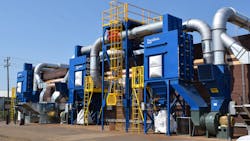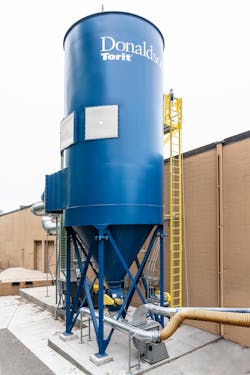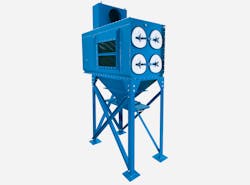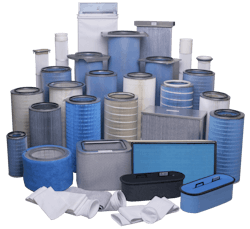Q&A: Dust collection system basics
Dust collection systems are critical to many powder and bulk processes to maintain the health and safety of workers and prevent combustible dust fires and explosions. Processing recently spoke with Chrissy Klocker, applications engineering manager at Donaldson Company, about the different collector types available and what processors should consider when choosing a dust collection system for their plant.
What are the different types of dust collectors available for industrial processors and how do they differ?
There are quite a few different types and styles on the market today, but for dry powder and bulk solids applications, the two most common categories are cartridge collectors and baghouse style collectors. Cartridge collectors use a pleated filter media, usually made from cellulose, while baghouse style collectors use a traditional felt filter media and are usually a lot bigger and made to handle larger air volumes.
What types of applications is each collector type best suited for and why?
Cartridge collectors are meant to handle finer dust particles. The filter media that goes into a cartridge collector can be made to separate a much smaller particle size from the airstream, in the micron and submicron range. For example, a cartridge collector with cellulose filter media is suited for dry and fine dust from thermally generated processes, such as welding, thermal spraying or plasma or laser cutting. Cartridge dust collectors are also well suited for dry bulk material handling processes such as pharmaceutical applications or the conveying of various dry bulk materials.
Because baghouses use felt filter media, they are generally more suited for larger particle sizes and industrial applications with higher air volumes and grain loadings. They can also handle higher temperatures, chemical applications, moisture and other nonstandard airstream characteristics.
What are the main factors to consider when selecting a dust collector?
There are many, but the main thing to target is the type of dust you are trying to collect. Again, submicron particle sizes will lean toward a cartridge style collector, while heavy-duty applications or nonstandard dusts will lean toward a baghouse.
Within the cartridge or baghouse technologies, you want to look at where the dust collector will be located. Whether the collector will be located outside or inside the building may impact footprint requirements or height restrictions. Sometimes process requirements can be a factor. For example, if the process airstream must be conditioned, the collector may need to be inside the building.
Another factor to focus on is how long you will run the process. If you have a critical process that needs to run 24/7, you will want to find equipment that is constructed and sized for that level of operation. If your application will only run for a couple hours each day, you may be able to size the system more aggressively or go with a different technology.
What are the most common types of dust collector filter media, and how can processors determine which type is most suitable for their system?
Cellulose and polyester media are the primary types on the market. Our standard cartridge media is called Ultraweb, which is a cellulose media with a fine fiber. Our standard baghouse media is called Duralife, which is a polyester media. What you need to look out for are the nonstandard airstream characteristics I mentioned previously. If you have high temperatures, moisture or chemicals in your airstream, you will need to look for a specialty media that is more suitable for those conditions.
Cellulose is made from the same thing as paper. If you get a piece of paper wet, it will start to wrinkle and weaken; the same is true for cellulose filter media. If you have moisture in your process, you will want to use a felt or polyester spun-bond type of media.
You also need to consider the dust’s physical properties. If you have a dust that is stringy or fibrous, such as shredded paper or cotton dust that may clump together, you may want a media with a wider pleat spacing or a different configuration. It is not only the media type but the filter configuration that can be important.
How can processors compare different dust collectors on the market?
I would recommend really looking at the system’s total cost of ownership. A lot of end users are just focused on the initial cost of the equipment. Dust collectors are definitely not cheap, especially when you start adding in all of the system components, but you should look at the operating costs as well as the initial costs. How much compressed air will the system use? How often will you need to perform maintenance? How long will the filters last? How long will the equipment itself last? All of these factors will impact the total cost of ownership and help you understand what an equipment manufacturer can do for you.
Dust collection equipment often seems the same across different manufacturers, so look at the manufacturer’s support for the equipment, both presale and post-sale. Does the manufacturer have service capability? Can they supply filters? These things can all factor into the total cost over the life of the equipment.
What should processors consider when determining where to locate a dust collector in their plant?
The first consideration is physical space. The amount of airflow you need and the volume of the material you are trying to move will dictate the size of the equipment. Do you have space to put the equipment inside your facility, or do you need to put it outside? Some processes will require that the equipment is located inside to keep the dust in a state that is easy to convey.
For example, if you collect sugar dust and convey it to a collector located outside in Louisiana, where it can be very hot, you are going to have melted syrup inside that dust collector, which will be a major material handling challenge. Some dust types, like sugar, need to be in a controlled environment where the air is conditioned, and the airstream is the same temperature throughout the collection system to make moving the material in and out of the collector a lot easier. For such materials, the process will dictate the collector location.
Regulatory or compliance issues may also come up. If you are handling combustible dust, locating the collector outside allows you to use different explosion mitigation strategies than if you locate the collector inside the building.
What are the most common causes of dust collector failure or inefficiency?
I would say lack of maintenance. Dust collectors tend to be forgotten in many cases. Companies want and need the system to work, but it is only when the system stops working that it gets attention. Keeping up with periodic maintenance is critical, such as checking the differential pressure across the filters to see if there is a leak or if the filters are nearing the end of their life and you need to order new ones.
You should also regularly check the compressed air to make sure it is clean and dry. Most traditional dust collectors have some sort of pulse-jet cleaning system that uses compressed air to clean the filters. The compressed air must be clean and dry to effectively clean the filter media. It is also a good idea to keep spare parts or repair kits on hand to fix leaks or failures. And check discharge containers to make sure there is no leakage and that they are sealed properly.
Also, check the airflow within the system to make sure you are not adding additional airflow or taking away from what your system is able to do. Process owners that constantly make modifications to their floor layout may not understand how duct changes or moving equipment on the floor will impact their overall system design and, therefore, the dust collector’s performance.
How can IoT-enabled monitoring improve dust collection system efficiency and reduce downtime?
Continuous IoT monitoring helps with assessing the overall health of the system, making sure it is operating as designed and alerting you prior to a failure. Monitoring differential pressure across the filter media is key to a system’s health. If the pressure starts trending upward, it is a great indicator that something is not right, such as the filters nearing the end of their life or poor compressed air. IoT monitoring alerts you that there is a problem before you have a failure.
How can processors determine whether IoT monitoring is cost-effective for their system?
It depends on how the end user intends to use the data. Some end users have to record differential pressure or airflow within their system to make sure that they are meeting specific system design criteria for regulatory requirements. If the EPA requires differential pressure monitoring, an IoT device is a great way to do that and generate a report every week or two showing how the system is performing.
The cost-effectiveness of IoT monitoring also depends on how critical your process is. If you are running the process 24/7, you want to be notified ahead of time about a potential failure or when you will need new filters. The IoT gateway sends alerts prior to an event occurring. If your application is only running 8 or 10 hours per day, you may have time to manually assess how the system is running, and you may not need an IoT monitoring device to alert you of potential problems.
How can processors reduce the likelihood and severity of a combustible dust explosion in their dust collection system?
Combustible dust is a huge topic. There are many different devices on the market and mitigation strategies to handle combustible dust but there are two main approaches. First, there are preventative techniques to reduce the likelihood of an event from happening. These include spark mitigation devices on the dust collector inlet as well as periodic maintenance and housekeeping measures. Second, there are protection devices that reduce the severity of an event once it occurs. These include explosion vents on dust collectors or chemical suppression systems. In combination, these different devices and strategies can reduce the likelihood and severity of a combustible dust event.
Donaldson Company






